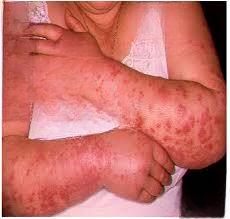What began as a routine adjustment in a patient’s chronic obstructive pulmonary disease (COPD) management quickly evolved into a perplexing medical puzzle. Within just two days of starting a new inhaler, a 55-year-old woman developed intensely painful, bright red patches across her face and neck, accompanied by a mild fever—a combination that left both the patient and her healthcare team concerned.
Though the visible symptoms resolved relatively quickly, the results of a skin biopsy revealed a surprising diagnosis: Sweet syndrome, a rare immune-mediated skin disorder. Even more striking, this may represent the first reported case linking an inhaled medication to the condition, raising important questions about hidden risks in widely used therapies.
Case Overview
The patient, a woman in her mid-50s, had a long-standing history of COPD and hypertension. Her medication regimen included enalapril for blood pressure management and a formoterol inhaler to support lung function. For years, she had been stable on this routine, with no significant complications.

However, as her respiratory function declined, her pulmonologist recommended a change in therapy. The patient was switched to a combination inhaler containing indacaterol and glycopyrronium, medications intended to enhance bronchodilation and improve breathing. Just 48 hours after starting the new inhaler, she noticed the rapid onset of painful red plaques across her face and neck, along with a low-grade fever.
The patient reported no recent changes in cosmetics, diet, or exposure to common allergens. She noted some sun exposure in the previous days, though she confirmed that she had used appropriate sun protection. Concerned by the abrupt appearance of these symptoms, her primary care physician referred her urgently to a dermatologist.
Clinical Evaluation
Upon evaluation, the dermatology team performed a thorough assessment. Blood tests were conducted to rule out infections and autoimmune causes. Laboratory results indicated no signs of bacterial or viral infection, and autoimmune markers were within normal limits. A skin biopsy was then performed, which confirmed the diagnosis of Sweet syndrome—a rare condition characterized by acute, painful, and inflamed skin lesions.
Following the diagnosis, the inhaler was immediately discontinued, and the patient was prescribed oral corticosteroids. Remarkably, her symptoms improved significantly within two days, and full recovery was observed over the subsequent week.
Understanding Sweet Syndrome
Also known as acute febrile neutrophilic dermatosis, Sweet syndrome is a rare disorder that typically presents with the sudden onset of painful, erythematous papules or plaques. These lesions are often asymmetrical and primarily affect the face, neck, upper torso, and hands. In addition to skin involvement, patients may experience systemic symptoms such as fever, fatigue, and elevated white blood cell counts.
The exact cause of Sweet syndrome remains unclear, but research suggests it is driven by an immune response involving cytokines, signaling proteins that regulate inflammation. Triggers may include infections, malignancies, autoimmune disorders, or medications. Known medication-related triggers include antibiotics, antiepileptic drugs, and vaccines.
Treatment typically involves corticosteroids, which reduce inflammation and help alleviate both skin and systemic symptoms. Early intervention is crucial, as delayed diagnosis can lead to prolonged discomfort and unnecessary complications.
Why This Case is Significant
What sets this case apart is the association between Sweet syndrome and an inhaled therapy, which has not been previously reported. While inhalers are commonly prescribed for COPD and other respiratory conditions, they are rarely linked to systemic immune reactions like Sweet syndrome.
Differential diagnoses—including contact dermatitis, urticaria, lupus, and other autoimmune or infectious skin disorders—were carefully considered and excluded. The rapid onset of lesions following the inhaler switch, along with the biopsy results, strongly supports a causative relationship.
This case underscores the importance of vigilance in primary care and pulmonary settings, where medication changes are routine. Sudden skin reactions after initiating a new therapy should prompt careful evaluation and early referral to specialists.
Clinical Implications
Sweet syndrome is rare and often overlooked in primary care, particularly when presenting after common treatments. Misdiagnosis or delayed diagnosis can prolong patient suffering and obscure the underlying cause. This case highlights several key lessons for healthcare providers:
- Monitor new medications closely: Even well-tolerated therapies can rarely trigger serious immune reactions.
- Recognize atypical presentations: Sweet syndrome may mimic other skin conditions. Rapid onset and painful plaques should raise suspicion.
- Timely intervention is crucial: Early use of corticosteroids can dramatically improve patient outcomes.
- Document unusual reactions: Reporting novel cases helps expand medical understanding and informs safer prescribing practices.
Patient Recovery and Follow-Up
Following corticosteroid therapy and discontinuation of the inhaler, the patient experienced a swift resolution of skin lesions and systemic symptoms. She returned to her baseline health within a week and remained under close follow-up to monitor her COPD management. Her original inhaler therapy was reconsidered, with the addition of alternative strategies to improve lung function without triggering immune responses.
The patient expressed relief at the quick intervention and noted that she felt well-informed throughout the process, highlighting the importance of clear communication between patients and healthcare providers.
Broader Medical Significance
While Sweet syndrome itself is rare, this case highlights a broader principle: any medication, even those perceived as low-risk, can occasionally provoke unexpected immune reactions. The findings emphasize the importance of integrating dermatology and immunology expertise into routine patient care, particularly when introducing new therapies.
For researchers, this case opens avenues for further investigation into the mechanisms behind medication-induced Sweet syndrome, including potential risk factors that could predict susceptibility. Understanding why certain patients develop these reactions may help prevent future cases and improve patient safety.
Educating Clinicians and Patients
This case serves as a reminder for clinicians to maintain a high index of suspicion for unusual reactions. Educating both healthcare providers and patients about warning signs can lead to earlier detection and treatment. Key educational points include:
- Identifying sudden, painful, red plaques or papules, especially when accompanied by fever.
- Considering recent medication changes as potential triggers.
- Encouraging patients to report new or worsening symptoms promptly.
- Coordinating care between primary care, dermatology, and pulmonology specialists.
Conclusion
This unusual case of Sweet syndrome linked to a COPD inhaler highlights that even common and widely prescribed medications can trigger rare but serious immune-mediated reactions. Clinicians should remain alert to sudden dermatologic changes, particularly after introducing new therapies. Early recognition and treatment can dramatically improve outcomes and prevent prolonged discomfort or complications.
By reporting and analyzing rare events like this, the medical community can improve diagnostic awareness, enhance patient safety, and expand understanding of immune-driven skin disorders. For patients, the case reinforces the importance of monitoring new medications and communicating concerns promptly.
Ultimately, this case emphasizes that rare adverse reactions can occur even with familiar treatments, and timely intervention, multidisciplinary collaboration, and careful observation are essential. Clinicians, patients, and researchers alike can learn from this case, ensuring that future occurrences are identified quickly and managed effectively, minimizing harm and improving quality of care.


